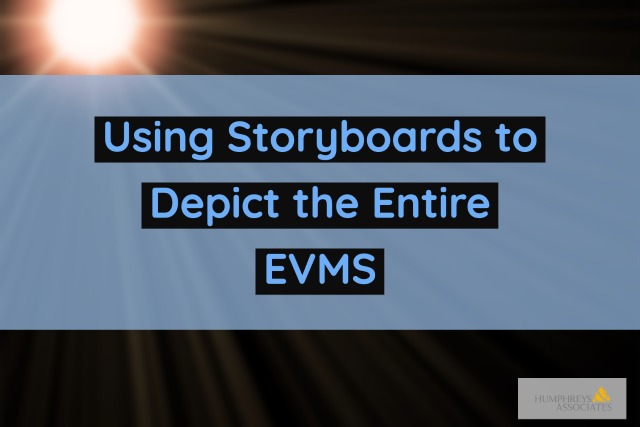
UPDATE#1 NOVEMBER 10, 2017
UPDATE#2 DECEMBER 15, 2020
DCMA Compliance Review
This is the third topic in a series discussing the DCMA Compliance Review (CR) process. It is the second update to the original series #3 Blog that was based on the instruction book from the DCMA Website that identified the “DCMA 16 Step (and then their 8-Step) EVMS Compliance Review Process.” This change was documented in the DCMA “Earned Value Management System Compliance Reviews Instruction (DCMA-INST 208).” This Instruction has been rescinded and replaced with a set of DCMA Business Practices (BP). These Business Practices split out topics the old DCMA Instruction 208 covered in one document. Whether you are a contractor new to the EVM contracting environment or a seasoned veteran, if the Earned Value Management System (EVMS) compliance and acceptance authority is the Defense Contract Management Agency (DCMA), these new Business Practices apply to you.
EVMS Storyboards
The focus of this discussion is on using EVMS Storyboards to assist with the interviews and data traces that are part of any internal EVMS review, as well as during the conduct of any of Compliance Review, Surveillance Review, or Review for Cause (RFC). Storyboards can also be useful in supporting on-going surveillance activities. Even more important is their usefulness for training contractor and government personnel in how the EVM System operates.
Depict the Management System
An EVMS Storyboard depicts the entire management system as stratified flow diagrams with artifacts illustrating the inputs and outputs that demonstrate the system in operation. It is meant to clearly illustrate:
- How the entire system functions (the flow),
- Who is responsible for doing what (decision points and actions),
- Products (forms, reports, outputs, and other artifacts), and
- How all the process groups are interrelated to create a fully integrated EVMS.
Single Thread
The storyboard should also illustrate a single thread trace to demonstrate data integrity from beginning to end using actual project artifacts. Storyboards are an essential tool for training all levels of users and is invaluable for demonstrating to a customer or a review team how a contractor’s EVM System functions.
Formats
Storyboards can take many forms. The entire process can be displayed on panels or poster boards on a conference room wall. It can be contained in the EVM System Description document as an overall flow, or as segmented flows in the system description sections corresponding to the process flow. It can also be electronic or online flow diagrams with links to live artifacts.
The DCMA EVMS Center has made it clear that EVMS Storyboards are an important part of the compliance review process. During a compliance review, the contractor would be expected to use these stratified flow documents to walk through the various system processes. This includes the project manager, integrated product team (IPT) leads, control account managers (CAMs), and other functional leads. The various users of the EVMS should be able to use the storyboard flow documents to help tell their “story” and demonstrate data traceability using live project artifacts.
Compliance Review
When preparing for any compliance review, be sure to step through your EVMS Storyboard to verify:
- It is complete and clearly illustrates how all the process groups are interrelated,
- Roles and responsibilities are unambiguous,
- Entrance and exit points are clearly marked,
- Artifacts are up to date,
- It accurately reflects how project personnel are using the EVMS to manage their work, and
- All the data represented on the storyboard traces properly.
What if I don’t have an EVMS Storyboard?
If you don’t have an EVMS Storyboard in place, consider starting with the flow diagrams in your EVM System Description and building them out into a storyboard. An EVMS Storyboard is an essential tool to successfully navigate the compliance review process. It can help to prevent DCMA Discrepancy Reports (DRs) or Corrective Action Requests (CARs) being written because the DCMA review team didn’t know how to locate certain documents, or they didn’t understand how a process worked.
Humphreys & Associates can help you develop a new EVMS Storyboard or enhance your existing EVMS Storyboard, an important and cost saving tool. To contact us, (click here) or call (714) 685-1730.
EVMS Compliance Review Series

Pingback: IPMR DID Office of Secretary of Defense publishes change in procedure - Humphreys & Associates
Pingback: IPMR DID Change – Office of Secretary of Defense publishes new procedure
Pingback: EVMS Compliance Review Prep for the DCMA 16-Step Review Process
Pingback: Updates to the Compliance Review Series of Blogs - Humphreys & Associates
Pingback: EVMS Compliance Review 2 – DCMA Contractor Self-Assessment
Pingback: EVMS Compliance Review #4 – Preparing for Interviews